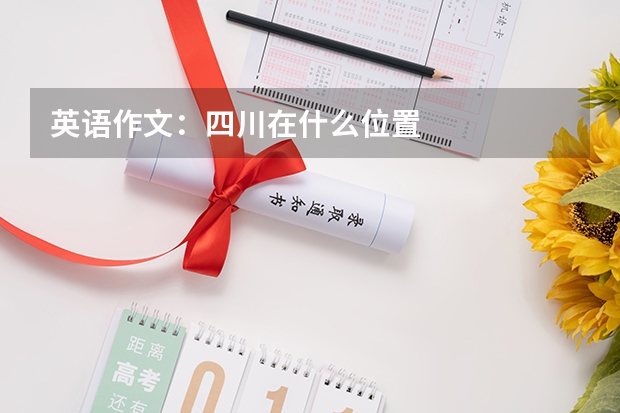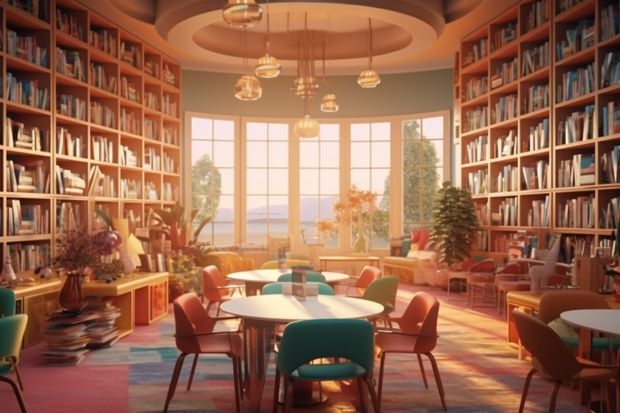英语作文:四川在什么位置
2024-12-29 11:23:05 | 炎炎英文培训网
本文目录一览:

有关四川的一次让人难忘的旅游的英语作文
Last sunday. I and my father went to sichuan. In the morning we came down the mountain. I saw wooded mountains, wild flowers bloom. We climb up the hill along the mountain path. Come halfway up the mountain, I feel a little tired,it began to rain,My West Lake silk umbrella missed,. Dad said to me,“liyang, don’t do anything halfway.”at last,So I insisted reached the top, the top of the scenery so beautiful.We were flying kites, .finally we went home.finally,Since then, I've kept the umbrella。i was very happy
介绍四川的英语作文
Jiuzhaigou Valley is located in the Aba Tibetan and Qiang Ethnic Autonomous Prefecture in western Sichuan Province. If you take a bird's eye view, you'll see it's shaped like the letter Y and stretches more than 40 kilometers. Nine ethnic Tibetan villages are scattered across the valley, so it's called Jiuzhaigou, or the nine-village-valley.Even for those who have traveled to many places in China, Jiuzhaigou is a pleasant surprise. Nerohem Yam from Israel is one example. The past few years have taken him to quite a few places of interest like Beijing, Shanghai, Zhejiang and Sha'anxi. But he fell in love with Jiuzhaigou's astonishing beauty at the very first sight.
"This is the most beautiful place in China. Because the landscape is very unique, the water colors are something exceptional, you don't see that in any other place in China."
The magic of Jiuzhaigou lies in the water, which is also where Jiuzhaigou's spirit resides. More than 100 alpine lakes of different sizes and brilliant colors are scattered in the valley.
The water is so pure and clear, you can count the pebbles, floating grass and fallen tree branches at the bottom. All the crystal-clear lakes have gorgeous colors, sometimes blue like sapphires or green like emeralds, and decorated with bright yellow touches.
Morishita Sadamasa, a tourist from Japan, can't help gasping in admiration.
"I have seen some videos of Jiuzhaigou's scenery back in Japan. But now that I'm here to see it in person, I find the view even more beautiful. There are lakes of the same kind in Japan, but I think Jiuzhaigou outstrips them all."
Jiuzhaigou's colorful waters come thanks to the conic karst landforms. The calcium, magnesium and carbonate ions abundant in the lake water are good at reflecting blue and green light. They also contain more than 200 types of algae in a variety of colors.
The lakes at Jiuzhaigou are located at different altitudes, creating the perfect environment for waterfalls to form. The valley has 17 waterfalls, including the 300-meter-wide Nuorilang Fall, the broadest single waterfall in China.
Little wonder the Chinese people call Jiuzhaigou Valley a fairyland on earth! It was included on the UNESCO World Natural Heritage List in 1992, but the local people have other reasons to take very good care of it.
A Tibetan girl, Yina Manhong, says the local Tibetans believe that everything inside the valley has been bestowed by divine powers.
"We local Tibetan people believe everything has a spirit and all those mountains and waters as well as trees and grasses are bestowed by the gods. We humans have every reason to protect them, not to damage them. The older people will tell their children not to wash clothes in the water or dispose anything filthy."
Yina Manhong and her fellow villagers still live in Jiuzhaigou Valley as their ancestors taught them to. They are friends with the natural world and hospitable to travelers who pass by.
One hundred thirty kilometers away from Jiuzhaigou Valley is another "Paradise on Earth," the Huanglong Park. It was included on the World Natural Heritage List in 1992, the same year as Jiuzhaigou Valley.
The Huanglong Park sprawls over 700 square kilometers and is surrounded by damp forests, mountains, coniferous woods and grasslands.
The region's big attraction is the karst formations that surface in the form of limestone pools, shoals and travertine falls.
People probably call this place Huanglong, or Yellow Dragon, because of the rock formations, which are just like yellow scales on the back of a gigantic dragon. The water is crystal clear and contains all kinds of minerals, drawn from the limestone mountain behind it. Each small pool displays heartbreakingly beautiful colors that would defy any painter's palette.
If you want to see the most charming part of Huanglong Park, you have to be on the mountaintop. It's three thousand meters above sea level and a non-stop walk from the bottom to the top takes about an hour. Altogether, it's a seven-kilometer uphill climb. The exertion can be a problem for many people. Kou Yahui, who is in charge of Huanglong Park, says they've found a solution to the problem.
"We now have tourist chair lifts, so travelers can take them to the mountaintop for sightseeing. We've also set up five cost-free oxygen bars for hikers along the way to the peak. They are totally free for travelers."
Once you get to the very top, you will find yourself at the Five-Color Pond, the eye of the Yellow Dragon. The surface ripples with baby blues and lush greens. The place is so dazzlingly unreal that people imagine it must be the place where goddesses come to bathe.
Alright, with a tour of this wonderland, we wind up today's trip to Sichuan. I'm YF. See you next time
英语作文:四川在什么位置
炎炎英文培训网(https://www.ywyaqi.com)小编还为大家带来英语作文:四川在什么位置的相关内容。
写作思路:主要写出四川的地理位置以及特点。 炎炎英文培训网
正文:
It is located in the inland of Southwest China, bounded by 26 n ° 03′~34 ° 19 ', 97 e ° 21′~108 ° It is connected to Chongqing in the East, Yunnan and Guizhou in the south, Tibet in the west, Shaanxi, Gansu and Qinghai in the north.
位于中国西南地区内陆,界于北纬26°03′~34°19′,东经97°21′~108°12′之间,东连重庆,南邻云南、贵州,西接西藏,北接陕西、甘肃、青海。
The landform of Sichuan is large and its terrain is complex and diverse. It is located in the transitional zone between the first grade Qinghai Tibet Plateau and the third grade middle and lower reaches of the Yangtze River in the three great steps of the Chinese mainland.
四川省地貌东西差异大,地形复杂多样,位于中国大陆地势三大阶梯中的第一级青藏高原和第三级长江中下游平原的过渡地带。
It is composed of mountains, hills, plains, basins and plateaus.Sichuan Province is divided into three major climates, namely, the humid climate in the middle subtropics of Sichuan Basin.
高差悬殊,地势呈西高东低的特点,由山地、丘陵、平原、盆地和高原构成。四川省分属三大气候,分别为四川盆地中亚热带湿润气候。
以上就是炎炎英文培训网小编整理的内容,想要了解更多相关资讯内容敬请关注炎炎英文培训网。更多相关文章关注炎炎英文培训网:www.ywyaqi.com免责声明:文章内容来自网络,如有侵权请及时联系删除。

四级作文写在第几张答题卡上1.英语四级是两张答题卡,先发作文答题纸,作文和快速阅读是一起的,开考大约40分钟后开始收.2.剩下的一张答题卡都是选择题的了,先听听力,做完听力试题以后,楼主完全可以根据自己的强项,先做容易的和自己上手的,最后做稍微难做点的,关键是要保证阅读理解的时间,因为,阅读理解占三分之一的分数,这张答题卡是考试结束铃声响起后再统一收起来的.祝楼主顺利过关.四级考

英语四级写作文时在哪个位置开始写英语四级写作文时在"从此处开始作答"上面开始写作文会全扣。英语四级总分为710份,其中英语四级作文分值占整张卷子的15%,四级作文分值为106.5分。四级英语作文是衡量学生英语综合水平和应用能力的一个重要指标,也是大学英语四级考试的一个重要内容。扩展资料:大学英语四、六级考试的原始分数在经过加权、等值处理后,参照常模转换为均值为500、

爱尔兰留学大学对于留学生的英语水平有一定要求爱尔兰的大学对于留学生的英语水平有一定要求,留学生需要达到相当的语言标准才能够成功申请。爱尔兰大学对本科留学生的语言成绩要求在,英语成绩达到雅思6分以上。留学生如果无法达到基本的语言要求,还可以申请爱尔兰的预科课程,只要留学生的英语成绩达到雅思4.5到5.5即可。另外,留学生也可以选择不提供英语成绩,而直接到爱尔兰就读语言学校,在进行为期3个月到1

2014年四级546,听力174,阅读202,作文与翻译170。分数等级在哪个位置。请问各位大神强人啊,人才,佩服。首先阅读能力很强,听力也不差,不过还有很大的提升空间,阅读也可以再进步一点,不过202分已经很不错了,至少要保持,听力最少要拿到200分,也就是还有26分的提升空间,加油。多锻炼听力。后面的作文和翻译已经很优秀了,记得要保持哦。英语四级作文真的可以中间乱写吗?不可以。

四川大学英语三级和CET-3有什么区别哦?没有四川大学英语三级吧。有四川省英语三级(全国公共英语考试PETS)和教育部的大学英语考试[CET-CollegeEnglishTest],CET没有三级,只要有四级和六级。全国公共英语等级考试(PublicEnglishTestSystem,简称PETS)是教育部考试中心设计并负责的全国性英语水平考试体系。PETS在考生资格方面,无年龄、职业、

什么是学位英语与英语考级有关系,倘若过了英语四级则不用重新考学位英语。学位英语:指成人本科学士学位英语统一考试(又称“成人英语三级”),是由各省级高等教育主管部门组织的统一考试。主要目的:为了客观地测试本地区非英语专业成人本科毕业生申请学士学位者的英语语言知识和运用能力,考查其是否达到普通本科教育(非英语专业)英语教学的一般要求,是各省市成人高等教育本科毕业生获得成人学士学位的必备条

求一个写北京的地理位置,人口,特产,面积的45字英语作文AsthecaptainofChina,Beijinghasbeenthemostpopularcityofchina.SomoreandmorepeoplewanttovisitBeijing.IthinkthebesttimetovisitBeijingisspring,fortheweatherofthattimeisvery

英语作文介绍黑龙江的地理位置和天气特点你好harbinisthecitywhichiwasbornin.itisaverybeautifulcity.itisfamousforiceandsnow.duringthewinter,manytouristsfromallovertheworldcometoharbintoattendtheharbininternationaliceands
- 四级英语作文四个模板及范文 大学英语四级作文必备的五大万能模板
- 英语作文:四川在什么位置
- 近四年英语四级作文范文 历年大学英语四级作文真题及范文汇总
- 6年级英语四级作文范文 英语四级作文万能模板
- 求历年的英语六级考试作文范文 12月全国大学英语六级考试作文真题及范文:互相理解
- 12月全国大学英语六级考试作文真题及范文:互相理解 四六级英语作文真题范文
- 六级必背作文模板四级范文 中考英语作文模板+必背短语
- 四级六级作文真题范文2022 下半年英语六级作文必备之写作佳句【3篇】
- 6月大学英语四级作文【三篇】 英语四级优秀作文范文
- 英语六级考试和四级考试的作文是一样的吗 ?
- 四级英语作文预测 英语四级作文范文
- 日语n3是个什么水平英语四级日语N3是个什么水平
-
 大学英语四级山东多少钱 英语四六级报名费是多少
大学英语四级山东多少钱 英语四六级报名费是多少2023-10-01 05:27:01
-
 参加银行招聘考试对英语四六级有要求吗?
参加银行招聘考试对英语四六级有要求吗?2024-03-08 21:21:17
-
 大学英语四级考试耳机名称 英语四六级考试用哪款耳机好
大学英语四级考试耳机名称 英语四六级考试用哪款耳机好2023-09-17 09:36:26
-
 英语专业四级作文跑题能给多少分?
英语专业四级作文跑题能给多少分?2024-11-14 21:49:07
-
 英语四六级考试是全国统一的吗?
英语四六级考试是全国统一的吗?2024-04-04 18:24:34
-
 大学英语四级考试sectionb什么意思 英语四级新题型中的Section B快速阅读答题技巧是什么呀?是直接看选项在原文中找还是先快速浏览
大学英语四级考试sectionb什么意思 英语四级新题型中的Section B快速阅读答题技巧是什么呀?是直接看选项在原文中找还是先快速浏览2023-09-24 08:22:41